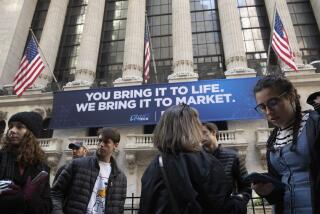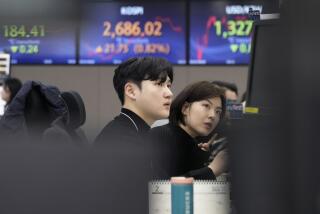S&P 500 ekes out a gain, extending its winning streak. Boeing slides

U.S. stock indexes took a round trip Monday, erasing their early-morning losses to end the day close to where they started.
The Standard & Poor’s 500 index eked out a small gain, enough to prolong its winning streak to eight days, its longest in a year and a half. But the Dow Jones industrial average lost ground as Boeing slid.
Most stock movements were only modest, and the market was nearly evenly split between winners and losers. Investors are looking ahead to a busy week for markets, with updates scheduled for corporate earnings, the U.S. economy and global trade.
The S&P 500 edged up 3.03 points, or 0.1%, to 2,895.77. It climbed to within 1.2% of its record, which was set in September, and had been down as much as 0.4% in morning trading.
The Dow slipped 83.97, or 0.3%, to 26,341.02. The Nasdaq composite rose 15.19, or 0.2%, to 7,953.88. The Russell 2000 index of small-cap stocks fell 3.55, or 0.2%, to 1,579.00.
Boeing was one of the biggest movers on the quiet Monday, slumping 4.4% after saying late Friday that it will cut production of its 737 Max plane. Regulators around the world grounded the jet model after it was involved in two fatal crashes that occurred within months of each other.
Boeing’s struggles have dragged on other stocks, including its customers and its suppliers. Spirit AeroSystems Holdings, an aerospace supplier, fell 5.1%. Southwest Airlines lost 2.5%.
On the winning side were energy stocks, which benefited from yet another climb for the price of oil.
Since hitting a bottom below $43 a barrel in December, benchmark U.S. crude has gained more than $20. It rose $1.32 on Monday to $64.40 a barrel. Brent crude rose 76 cents to $71.10 a barrel.
The gains helped energy stocks in the S&P 500 rise 0.5%, the biggest gain among the 11 sectors that make up the index.
The market’s trend has been decidedly upward in recent weeks as stocks have climbed, mostly in small increments. That follows a torrid start to the year: The S&P 500 surged, notching its best quarter in nearly a decade, after the Federal Reserve eased fears about a recession by saying it may not raise interest rates at all in 2019.
Investors will get more clues this week about the Fed’s intentions. On Wednesday the central bank will release the minutes from its last policy meeting. A report on consumer prices due out the same day will show whether inflation remains modest, which would give the Fed more leeway to keep interest rates low.
Earnings reporting season will begin in earnest at the end of this week, with JPMorgan Chase and other big banks set to tell investors how much they earned during the first three months of the year. Expectations are low for the market broadly, and analysts are forecasting that S&P 500 companies will have their first drop in profits in years.
That puts more focus on what chief executives say about their prospects for the rest of the year. Analysts expect profit growth to resume after the weak first quarter, and if CEOs undercut those beliefs, it would weigh on stock prices.
“We’re watching the earnings and the drivers of earnings,” said Doug Ramsey, chief investment officer of Leuthold Group. He’s paying particular attention to how much of each $1 in revenue companies can hold on to as profit, as wages and interest expenses on their debts rise.
Investors are also watching across the Atlantic, as Britain’s prime minister prepares to meet continental European leaders ahead of a Friday Brexit deadline, when Britain is scheduled to depart the European Union. Economists worry about the drag on trade and the economy if the departure happens without a withdrawal agreement.
All this comes against a backdrop of heightened worries about global economic growth and a global trade war. Growth has slowed, and investors are debating how much last week’s stronger-than-expected report on U.S. jobs changes the picture.
China’s official news agency said Sunday that trade talks with the United States in Washington last week “achieved new progress,” but it did not elaborate on where or when further discussions will happen. Beijing and Washington are working to end a standoff over Beijing’s industrial and technology policies that has shaken financial markets and darkened the world economic outlook.
The dollar slipped to 111.53 yen from 111.71 yen. The euro rose to $1.1261 from $1.1218, and the British pound climbed to $1.3066 from $1.3029.
Gold rose $6.30 to $1,301.90 an ounce. Silver rose 13 cents to $15.22 an ounce. Copper rose 4 cents to $2.93 a pound.
Natural gas rose 4 cents to $2.71 per 1,000 cubic feet, heating oil rose 1 cent to $2.06 a gallon, and wholesale gasoline rose 2 cents to $1.99 a gallon.
The yield on the 10-year Treasury note ticked up to 2.52% from 2.50%.






